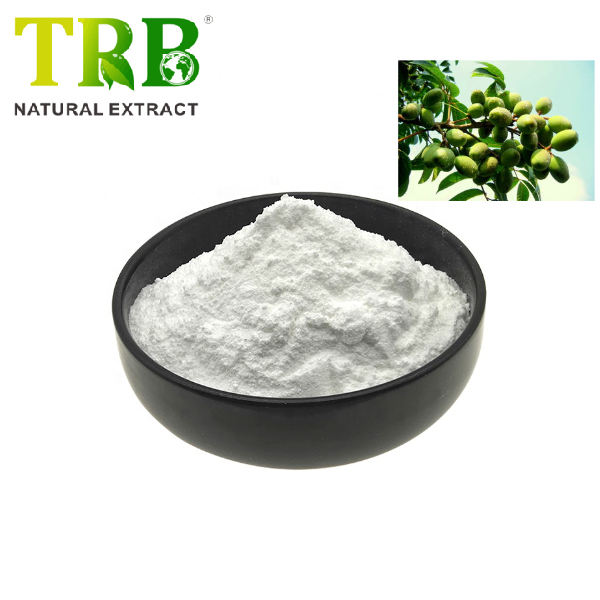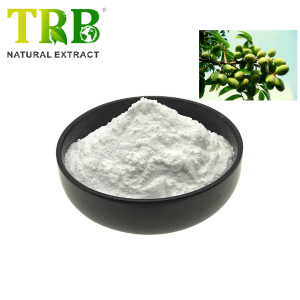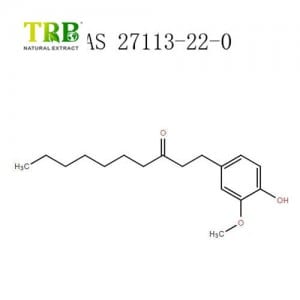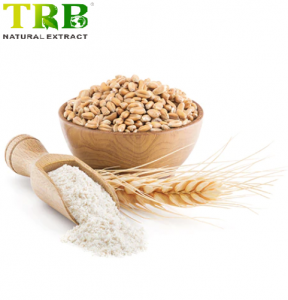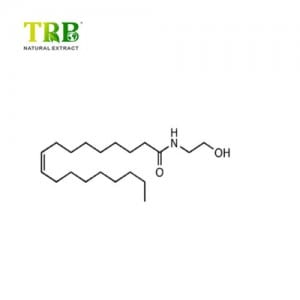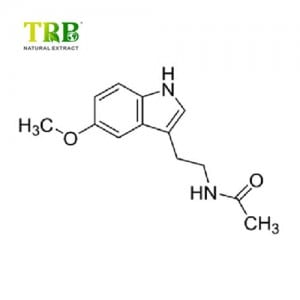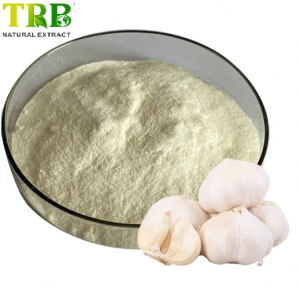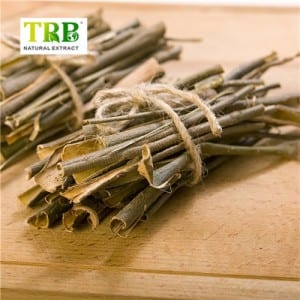Oleanolic acid o se tolu pentacyclic triterpenoids vavae ese mai Gentianaceae laau o Swertia mileensis le mutia atoa po o privet fua, faatasi ai ma se tino saoloto ma glycosides i le tele o laau.Oleanolic acid o loʻo i ai le lautele o laʻau, ma o le averesi o mea o loʻo i totonu o le 0.2% - 2%.Cucurbitaceae mea maualuga o le 1.5% ~ hunchback pito i lalo 2%, privet fua o loo i totonu o le 0.6% ~ 0.7%. Oleanolic acid o se ituaiga o pentacyclic triterpenoid tuufaatasiga vavae ese mai le fua o le ituaiga Asteraceae, Syzygium sylvestris, po o Ligustrum lucidum.Ose fa'ama'i ate ma fa'aoga fa'apitoa mo togafitiga fa'ama'i.Ma'i jaundice hepatitis ei ai aafiaga manino i le faaitiitia alanine aminotransferase ma samasama. Oolic acid o se triterpenoids pentacyclic vavae ese mai le fua o le swertia chinensis po fructus ligustris mai le laau gentianaceae.Oleanolic acid o loʻo maua lautele i laʻau, faʻatasi ai ma le lautele o le 0.2% ~ 2% [1].O le mea o loʻo i lalo o le ipu o le 1.5% ~ 2%, ma le mea o loʻo i totonu o fua o le fructus ligustris e 0.6% ~ 0.7%.Oleanolic acid ole tioata pa'epa'e (ethanol), leai se manogi ma leai se tofo.Le mautu i acids ma bases.Liusualili tulaga o le 308 ~ 310 ℃, [alpha] 20 d + 73.3 ° (c = 0.15, chloroform, insoluble i le vai, soluble i methanol, ethanol, ethyl ether, acetone ma chloroform. Oleanolic acid o se triterpenoid masani ona tupu, lautele tufatufaina atu. i meaʻai ma vailaʻau, e fesoʻotaʻi ma le betulinic acid E mafai ona maua i le Phytolacca americana (American pokeweed), ma le Syzygium spp, garlic, ma isi.
Ole oleanolic acid na maua e fa'aalia ai le malosi e tete'e ai i le HIV, o le vaila'au betulinic e feso'ota'i sa fa'aogaina e fai ai le vaila'au fa'agata fa'atauga muamua.Na muamua suʻesuʻeina ma vavae ese mai le tele o laʻau, e aofia ai Rosa woodsii (lau), Prosopis glandulosa (lau ma lala), Phordendron juniperinum (laʻau atoa), Syzygium claviflorum (lau), Hyptis capitata (laʻau atoa), ma Ternstromia gymnanthera (aerial). vaega).O isi ituaiga o Syzygium e aofia ai le apu java (Syzygium samarangense) ma apu rosa o loʻo iai.
Igoa oloa: Oleanolic Acid98%
Faʻamatalaga: 98% e HPLC
Punavai Fa'asao: Olea Europea Extract
Igoa Vailaau:(3β)-3-Hydroxyolean-12-en-28-oic acid
Numera CAS:508-02-1
Vaega Fa'aaogaina: Laulau
Lanu: Pa'epa'e pa'epa'e ma uiga manogi ma le tofo
Tulaga GMO: GMO Free
afifiina: i 25kgs fibre talipalau
Teuina: Taofi le atigipusa e le tatalaina i se nofoaga malulu, matutu, Taofi ese mai le malamalama malosi
Ola Faʻamau: 24 masina mai le aso na gaosia ai
O le aoleanolic acid?
Oleanolic acid (OA), o le hydroxyl pentacyclic triterpenoid acid (HPTA) e tutusa ma le betulinic acid, ursolic acid;e iai fa'amanuiaga e pei ole antibacterial, anti-inflammatory, antitumor activities.

O fea e te maua aioleanolic acid?
Oleanolic acid ua faʻaaogaina masani mo togafitiga o faʻamaʻi eseese, e mafai ona e mauaina i meaʻai ma laau lautele.
O nisi o fua e pei o apu, rimoni, tipolo, piliki, olive e iai fo'i le oleanolic acid.

| Suafa Igoa | Oleanolic acid mea e maua | Su'ega metotia |
| Ligustrum lucidum Ait | 0.8028% | HPLC |
| Verbena Officinalis L | 0.071%-0.086% | HPLC |
| Prunella vulgaris L | 3.47%-4.46% | HPLC |
| Hemsley Chinensis Cogn. | 1.5%~2% | HPLC |
I le taimi nei, vao SainaHemsley Chinensis Cogno lo'o avea pea ma mea fa'atau pisinisi mo le su'eina ole oleanolic acid.
Hemsley Chinensis Cogn.Folasaga
Hemsleya chinensis Cogn.ose la'au a'e fa'aletausaga, o vaila'au fa'aSaina fo'i.
Aiga: Cucurbitaceae
Tribus: Gomphogyneae
Genus: Hemsleya
Ituaiga: H. amabilis
O le vao e tufatufaina atu i itumalo o Guangxi, Sichuan, Guizhou, Yunnan, Hubei, ma isi. Fanau i le pito o le vaomatua ma vanu vao i le maualuga e tusa ma le 2,000 mita.
Mea aoga: e aofia ai Hemslolide Mal, Ma3, H1;Chikusetusaponin-Iva;dihydro cucurbitacin F-25-acetate;dilydrocucurbitacin F;oleanolic acid-beta-Hlucosyloleanolate;Hemsamabilinin A;Cu-curbitacinⅡb-2-beta-D-glucopyranoside.
Tulaga Fa'afoma'i:
Hemsleya chinensis Cogn.e masani lava mo detoxification, sterilization, anti-inflammatory, faʻamalosia le manava ma faʻamalolo tiga.I le taimi nei, o loʻo i ai mea faʻapipiʻi paʻu, poʻo vailaʻau faʻapipiʻi e pei o capsules, tablets, gastrointestinal pill, ma isi, lea e faʻaaogaina lautele i falemaʻi.

Aveese ole oleanolic acid maiHemsleya Chinensis Cogn.

Fuafuaga o lo'o iai ole oleanolic acid i mea'ai fa'aopoopo
Na matou iloa o le oleanolic acid o loʻo faʻaaogaina i mea faʻalesoifua maloloina e masani lava ona maua mai i ituaiga e tolu o laʻau: Loquat lau laʻau, Hemsley Chinensis extract, ma le basil extract.
- Pa'u Basil pa'u (la'au) (0.4% Ursolic acid ma Oleanolic acid, 2.0 mg)
- O le Basil Paia supercritical CO2 extract (lau) (Ocimum tenuiflorum Linn.) (2.5% Ursolic acid ma Oleanolic acid, 1.5 mg)
- Loquat Extract (fua) (tuuina atu Ursolic acid, Oleanolic Acid) (Fa'ata'atia ile Ursolic acid ile Tu'uina 125mg)

Oleanolic acid VS Ursolic acid
Oleanolic acid (OA) ma le ursolic acid (UA) o triterpenoids fa'ale-natura e iai se fausaga fa'aletino tutusa.
O nei fa'apotopotoga triterpenoids ua iloa o lo'o iai i la'au fa'afoma'i ma mea'ai.
E tele a latou mea tau vailaau masani: hepatoprotective, anti-inflammatory, antimicrobial, hypoglycemic, antimutagenic, anti-HIV activity, antioxidant, ma antifertility activities.

OA ma le UA eseesega:
| Igoa Oloa | Oleanolic acid | Ursolic acid |
| CAS NO. | 508-02-1 | 77-52-1 |
| Pentacyclic triterpenes | β-Amyrin | α-Amyrin |
| Punavai laau | Loquat lau, Basil Paia, Rosemary, lau olive.etc. | |
| Fa'amatalaga | 40%,98% pauta | 15%,25%,50%,98%pauta |
| Fa'aaliga (lanu ma le manogi) | 40% samasama mama98% paʻepaʻe paʻepaʻe leai se manogi | 15% -50% lanu enaena-samasama po'o samasama98% pa'epa'e pa'epa'eAiga |
| Fa'ailogaina | IR:(1355~1392cm-1) lua tumutumu(1245~1330cm-1) tolu tumutumuNMR:δ(C12)122.1,δ(C13)143.4 | (1355~1392cm-1) tolu tumutumu(1245~1330cm-1) tolu tumutumuδ(C12)125.5,δ(C13)138.0 |
| Fa'atupuina | Oleanolic sodium saltOleanolic acid phosphate disodium salt3-oxo oleanolic acid bardoxolone methyl (CDDO-Me) | Ursolic sodium masima ma lona dicarboxylic acid afa ester e maua mai Ursolic acid ketene mea e maua mai ai 3-carbon ursolic acid 3-acetoxyursolic acid |
| E ono mafai ona maua ai le kanesa | UA e sili atu ona lauiloa nai lo OA. | |
Gaoioiga Fa'aletino ole Oleanolic Acid
-
Anti-Tumo/Ati-Kanesa Aafiaga
Aafiaga faʻalavelave ole oleanolic acid ile kanesa hepatocellular e ala ile ERK-p53-mediated cell cycle puʻeina ma le mitochondrial-dependent apoptosis
- saunia e Xin Wang, Hua Bai, ma isi Tagata suʻesuʻe
OA na fa'aalia se aafiaga fa'alavelave i le HCC e ala i le fa'aosoina o le apoptosis ma le pu'eina o le si'osi'omaga i totonu o toto toto ma i sela HepG2.
OA faʻaosoina apoptosis e ala i le ala mitochondrial, faʻamaonia e ala i le faʻasaina o le Akt / mammalian taulaʻi o le ala rapamycin.
OA na fa'aosoina le G2/M fa'aoso le si'osi'omaga pu'eina e ala i le p21-mediated down-regulation of cyclin B1/cdc2.
OA na faʻaalia ni gaioiga taua tele i le HCC i vivo ma in vitro faʻataʻitaʻiga.O nei fa'amaumauga e maua ai se fa'amatalaga fou i le faiga o lo'o i lalo ole a'afiaga ole tumor ole OA.
E le gata i lea, o suʻesuʻega o loʻo faʻaalia ai o le OA ma le oleanolic acid methyl ester e iai foi aʻafiaga i le kanesa o le susu, kanesa o le mama, kanesa o le manava, kanesa o le manava, sela o le kanesa pancreatic ...

-
Gaoioiga Antimicrobial
O le OA o loʻo faʻamoemoeina e iai se gaioiga faʻamaʻi faʻamaʻi e tetee atu ai i le tele o faʻamaʻi pipisi aua e iai sona sao taua i le puipuia mai faʻamaʻi i totonu o laʻau.
Ole OA na fa'aalia le gaioioiga fa'asaga ia Staphylococcus aureus ma Bacillus Thuringiensis ile 62.5 µg/mL ma le Escherichia coli, Salmonella Enterica, ma Shigella dysenteriae ile 31.2 µg/mL la'ititi fa'asa'o fa'atonuga (MIC).
-
Malosiaga Hepatoprotective
O se tasi o gaioiga iloga o le OA o le puipuia lea o le ate mai le oona ma o loʻo faʻaaogaina nei e avea o se vailaʻau faʻatau atu ile ate i Saina.
I isumu Wistar albino, OA mai Flaveria Trinervia na faʻaaogaina ma e iai sona aafiaga puipuia tele i le oona o le ate e mafua mai i le ethanol e ala i le toe faʻafoʻiina o le maualuga o le enzyme faʻailoga o le toto hepatotoxic.O lenei suʻesuʻega na faʻaalia ai le malosi faʻamaʻi o le OA o se isi auala e mafai ona faʻaogaina ai lona malosi hepatoprotective.
Oleanolic Acid ma ona mea e maua mai ai

Oleanolic Acid Su'ega Fa'afoma'i
Oleanolic acid (puna mai le olive), e tusa ma le 500 su'esu'ega falema'i resitalaina, na fa'aalia ai le aoga o a'afiaga i su'esu'ega fa'afoma'i i fa'ama'i fatuga'o tumau, ma'i suka ituaiga 2, ma nisi o ma'i tiga e pei o le gugu.
O le tele o mea e maua mai i su'esu'ega fa'apitoa o le bardoxolone methyl (CDDO-Me).O le CDDO-Me na su'esu'eina i biopsies tumo, ma e ono mafai ona faia se sao i le togafitiga o ma'i fatuga'o tumau, o lo'o iloiloina nei i aafiaga i le toto maualuga.
Fa'aSaina Pharmacopoeia Tulaga ole Oleanolic Acid
| Igoa o oloa | Oleanolic acid |
| Fa'ailoaga | (1) Ave le 30mg o lenei oloa, tuʻu i totonu o se paipa suʻega, faʻaopopo le 3ml chloroform e faʻamavae, faʻaopopo lua mataua o le sulfuric acid, lulu mo le 5 minute, o le chloroform layer e lanu viole-mumu. |
| (2) Ave pe a ma le 20mg o lenei oloa, faʻaopopo le 1ml o le acetic anhydride, faʻamavae ma sina vevela, faʻaopopo le sulfuric acid i le lanu viole, ma faʻapogisa pe a uma ona tuʻu. | |
| (3) Ave pe a ma le 10mg o lenei oloa, faʻaopopo le vanillin glacial acetic acid solution (ave le vanillin 0.5g, faʻaopopo le 10ml o le glacial acetic acid e faʻamavae, o lona uiga) 0.2ml, faʻaopopo le 0.8ml o le perchloric acid, ma faʻamafanafana mo ni nai minute i totonu o se vai taele.Fuchsia, faʻaopopo le 2ml o le ethyl acetate, lanu viole-mumu faʻafefete i le ethyl acetate, tuʻu e aunoa ma le faʻailoga. | |
| (4) Ole alaleo ole absorption infrared o lenei oloa e tatau ona ogatasi ma le fusi o alaleo pulea. | |
| Fuafuaga ole su'ega | Ave le 0.15g o lenei oloa, fua lelei, faʻaopopo le 30ml o le ethanol, lulu, faʻamafanafana i totonu o se vai vai mafanafana e faʻamavae ai, faʻamalie i le vevela o le potu, faʻaopopo 3 mataua o le phenolphthalein indicator solution, fai le potassium hydroxide solution ma le ethanol ( 0.05mol/L) Vave vave ma sa'o mo su'ega avanoa.Fofo o le potassium hydroxide (0.05 mol/L) i le 1 ml o le ethanol e tutusa ma le 22.84 mg o C.30H48O3. |
Oleanolic acid e fautuaina le fua
E tusa ai ma le Chinese Pharmacopoeia Standard, Oleanolic acid Oral dose o le 20 ~ 80mg i le taimi, 60 ~ 240mg i le aso.
Oleanolic acid a'afiaga itu
Oleanolic acid na fa'aaogaina e fai ma vaila'au hepatoprotective i luga ole fa'atau (OTC) mo le tele o tausaga i Saina.
Afai e sili atu pe le sa'o, o se vaega to'aitiiti o tagata mama'i e mago le gutu, manava manava, fa'aletonu le manava pito i luga, ma e mafai ona mou atu pe a mae'a togafitiga fa'ailoga.
Fa'amolemole fa'afeso'ota'i lau foma'i po'o le foma'i a'o le'i fa'aogaina lenei oloa.
Galuega:
1. Oleanolic acid e le o se mea oona, antitumor, ma le hepatoprotective, faʻapea foʻi ma le faʻaalia o mea faʻamaʻi.
2. Oleanolic acid na maua e fa'aalia ai le malosi o le anti-HIV.
3. Oleanolic acid o se puipuiga tele o sela e faasaga i le faʻamaʻi faʻamaʻi ma le electrophile.
4. Oleanolic acid ei ai aafiaga tele i trating virus hepatitis, maʻi hepatitis icteric ma hepatitis faaumiumi.
Talosaga:
1. Faʻaaogaina i fanua taumafa, e mafai ona galue e pei o mea mata o lauti e faʻaitiitia ai le phlegm;
2. Faʻaaogaina i vailaʻau faʻamaʻi, e avea ma vailaʻau faʻamaʻi-kanesa fou ma le maualalo oona;
3. Faʻaaogaina i totonu o mea teuteu, e mafai ona faʻamalosia le toto ma aveese meainu.
| Fa'amatalaga atili o le TRB | ||
| Fa'atonuga fa'atonutonu | ||
| USFDA,CEP,KOSHER HALAL GMP ISO Tusipasi | ||
| Tulaga Fa'atuatuaina | ||
| Toeitiiti atoa le 20 tausaga, auina atu i fafo 40 atunuu ma itulagi, sili atu i le 2000 vaega na gaosia e le TRB e leai ni faʻafitauli lelei, faiga faʻamamā tulaga ese, faʻaleagaina ma le mama pulea faʻafeiloaʻi USP, EP ma CP | ||
| Faiga Tulaga Autasi | ||
|
| ▲Faiga Fa'amautinoaga Tulaga | √ |
| ▲ Puleaina o pepa | √ | |
| ▲ Faiga Fa'amaonia | √ | |
| ▲ Faiga a'oa'oga | √ | |
| ▲ Maliega Su'etusi Lotoifale | √ | |
| ▲ Suppler Suetusi System | √ | |
| ▲ Faiga Fa'atonu Mea | √ | |
| ▲ Faiga Pulea Mea | √ | |
| ▲ Faiga Fa'atonuga | √ | |
| ▲ Faiga Fa'ailoga Fa'ailoga | √ | |
| ▲ Faiga Fa'atonu Falesu'esu'e | √ | |
| ▲ Faiga Fa'amaonia Fa'amaonia | √ | |
| ▲ Faiga Fa'atonu Fa'atonu | √ | |
| Pulea Punaoa Atoa ma Fa'agasologa | ||
| Pulea lelei mea uma, mea fa'aoga ma mea fa'apipi'i. E mana'omia mea mata ma mea fa'apipi'i ma mea fa'apipi'i fa'asoa fa'atasi ma le US DMF numera. E tele fa'atau oloa e fai ma fa'amautinoaga o sapalai. | ||
| Malosi Faalapotopotoga Felagolagomai e lagolago | ||
| Inisetiute o botany/Fa'alapotopotoga ole microbiology/A'oga o Saienisi ma Tekinolosi/Iunivesite | ||
